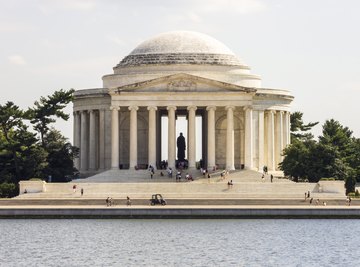
Acid rain, first recognized in Sweden in 1872, was considered a local problem for a long time. But in the 1950s recognition that acid rain in Scandinavia originated in Britain and northern Europe showed instead that acid rain was a regional, even global, problem.
Although rain is naturally a little acidic, the effects of acid rain on buildings and monuments accelerates natural corrosion and erosion.
Acid Rain and pH
Rain is naturally a little acidic, meaning its pH is below a neutral pH of 7. The pH scale measures how acidic or basic a substance is. It ranges from 0 (very acidic), to 14 (very basic).
Normal rain generally ranges from about 6.5 to about 5.6 on the pH scale. Acid rain, however, measures below 5.5. Acid rain has been measured at the bottoms of clouds at pH 2.6, and in fog in Los Angeles, as low as 2.0.
How Does Rain Become Acidic?
Water dissolves more substances than any other known material. Pure water only stays pure until it touches something else. When water vapor condenses around a particulate floating in the air, the water may dissolve or react with the particulate. When the particulate is dust or pollen, the rain carries the particle to the ground.
When the particulate carries or contains chemicals, a reaction can occur. As water vapor bounces around in the atmosphere, some of the water molecules react with carbon dioxide molecules to form carbonic acid, a weak acid.
This lowers the pH of the rain from 7 to about 5, depending on the concentration of carbonic acid. Natural buffers in the soil usually mediate this mildly acidic rain.
Naturally Occurring Acid Rain
Naturally occurring acid rain can also be caused by volcanic eruptions, rotting vegetation and forest fires. These events release sulfur and nitrogen compounds into the air while also providing particulates (smoke, ash and dust) for water vapor to clump around.
Water vapor reacts with sulfur compounds like hydrogen sulfide to form sulfuric acid and with nitrogen compounds to form nitric acid. These acids have much lower pH levels than carbonic acid.
Burning fossil fuels in automobiles, trucks, factories and power stations release sulfur and nitrogen compounds into the atmosphere, just like volcanoes and forest fires. Unlike volcanic eruptions and forest fires, however, these sources of air pollution continue over long periods of time.
These plumes of air pollution can travel long distances. The effects of air pollution on materials and structures ranges from surface dirt and stains to corrosion of the materials.
Effects of Acid Rain on Buildings and Monuments
Common naturally occurring materials used for buildings and monuments include sandstone, limestone, marble and granite.
Acid rain corrodes all these materials to some degree and accelerates natural decomposition. Limestone and marble dissolve in acids. The sand particles forming sandstone often are held together by calcium carbonate, which dissolves in acid.
Granite, while much more resistant to acid, still can be etched and stained by acid rain and the pollutants it carries. Cement also reacts to acid rain. Cement is calcium carbonate, which dissolves in acid. Concrete buildings, sidewalks and artwork made with cement show the effects of acid rain. In addition, slabs of granite and other decorative materials are often held in place using Portland cement.
Acid rain damage to concrete buildings in heavily polluted cities like Hangzhou, China, can be extensive. Copper, bronze and other metals react with acids as well. Corrosion of the bronze sheeting on the Ulysses S. Grant Memorial, for example, shows as green streaks down the pedestal. Copper dissolved from the bronze has washed down the base and oxidized into green stains.
Monuments Affected by Acid Rain
The effect of acid rain on Taj Mahal structures serves as one example of how acid rain impacts buildings. Air pollution from a local refinery has caused acid rain to form, turning the white marble yellow.
Although some have argued that the yellowing is natural, or caused by iron supports in the marble, the local courts agreed that air pollution has impacted the Taj Mahal. In response, the Indian government has established local strict emission controls to help protect the Taj Mahal.
The Thomas Jefferson Memorial in Washington, D.C., is one of many monuments affected by acid rain. The dissolving calcite releases the silicate minerals contained within the marble. The loss of material weakened the structure enough that reinforcing straps were added during the 2004 restoration. In addition, a black crust left by dirt caught in the etched marble must be gently washed away.
Many sculptures throughout the United States and Europe are carved from marble or limestone. When sulfuric acid rain strikes these statues, the reaction of the sulfuric acid with the calcium carbonate yields calcium sulfate and carbonic acid. The carbonic acid further breaks down into water and carbon dioxide. Calcium sulfate is water-soluble so washes away from the statue or sculpture.
Sadly, due to acid rain statue details disappear as the stone literally washes away.
References
- Elmhurst College: Acid Rain - Natural "Acid" Rain
- Elmhurst College: pH Scale
- North Carolina State University: What is Acid Rain?
- International Journal of Low-Carbon Technologies: Effect of Acid Rain on Economic Loss of Concrete Structures in Hangzhou, China
- U.S. Geological Survey: Water as Acid Rain
- Elmhurst College: Acid Rain Effects on Buildings
- Smithsonian Magazine: How to Save the Taj Mahal?
About the Author
Karen earned her Bachelor of Science in geology. She worked as a geologist for ten years before returning to school to earn her multiple subject teaching credential. Karen taught middle school science for over two decades, earning her Master of Arts in Science Education (emphasis in 5-12 geosciences) along the way. Karen now designs and teaches science and STEAM classes.
